Calit2 Project Showcases High-speed Mobile Web Access
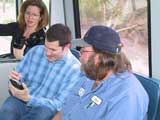 The bus is traveling 65 miles per hour down Interstate 5. The students on board the so-called CyberShuttle are traveling at 650 Kilobits per second down the Information Superhighway, downloading videos and cruising the Internet at speeds until now reserved for DSL or cable modem connections. It's all part of a Calit²-sponsored research project to test the limits of the wireless Web--and give students and researchers a look at where the mobile, high-speed Internet is headed. In this case, onto the open road.
The bus is traveling 65 miles per hour down Interstate 5. The students on board the so-called CyberShuttle are traveling at 650 Kilobits per second down the Information Superhighway, downloading videos and cruising the Internet at speeds until now reserved for DSL or cable modem connections. It's all part of a Calit²-sponsored research project to test the limits of the wireless Web--and give students and researchers a look at where the mobile, high-speed Internet is headed. In this case, onto the open road.
On April 1, Calit² and UCSD unveiled the CyberShuttle. The bus is the world's first to enable Internet access at a peak speed of 2.4 Megabits per second-even while the bus is traveling at 65 miles per hour. "It gives a whole new meaning to the term telecommuting," said Jack White, a computer resource specialist with UCSD's parking and transportation department. "While you are commuting between the train station and the campus, you can be wirelessly navigating the Internet at speeds comparable to what you would get at home using a DSL or cable modem."
At a news briefing and demonstration, Calit²'s UCSD division director Ramesh Rao noted that the CyberShuttle is part of ongoing research into the ways that competing technologies can be combined. The bus combines a fully mobile 802.11b wireless local area network inside the bus, with Web access through QUALCOMM's CDMA2000 1xEV wireless wide area data network installed on top of the UCSD Jacobs School of Engineering's main building and at the QUALCOMM's headquarters nearby.
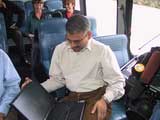 "Thanks to QUALCOMM, we have access to the most advanced wireless network in the world," said Rao, a leading wireless expert. "Now we are tapping into that network, and encouraging our researchers and industry partners to develop new services and technologies that lead to anytime/anywhere high-speed access to the World Wide Web."
"Thanks to QUALCOMM, we have access to the most advanced wireless network in the world," said Rao, a leading wireless expert. "Now we are tapping into that network, and encouraging our researchers and industry partners to develop new services and technologies that lead to anytime/anywhere high-speed access to the World Wide Web."
"Our students and faculty are getting a taste today of wireless technology that most of the world will not be using until years from now," Elazar Harel told reporters. Harel, the university's Assistant Vice Chancellor for Administrative Computing and Telecommunications (ACT), added that "this bus is one of the first places where we'll be able to experiment with technical as well as social aspects of third-generation (3G) wireless services in a real-world environment." The CyberShuttle is part of an ongoing initiative undertaken by ACT, UCSD's Irwin and Joan Jacobs School of Engineering, and Calit².
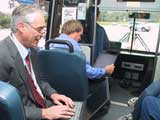 Also on hand for the announcement: Roberto Padovani, chief technology officer at QUALCOMM, who stressed the importance of cooperation between his company and university researchers within UCSD and Calit² who have been testing 1xEV technology for more than a year.
Also on hand for the announcement: Roberto Padovani, chief technology officer at QUALCOMM, who stressed the importance of cooperation between his company and university researchers within UCSD and Calit² who have been testing 1xEV technology for more than a year.
UCSD is also operating an 802.11b wireless network on campus, although the CyberShuttle is the first mobile application of the so-called Wi-Fi technology. "The campus already has 1,200 users registered to use 802.11, and all of them can just as easily log on while riding the bus," said Greg Hidley, head of technology infrastructure for Calit² and director of Engineering Computing for the Jacobs School. "To use their laptops or personal digital assistants online, all they need is the same wireless card they use elsewhere on campus, and they are automatically handed off from the local network, through the 1xEV network, to the Internet."
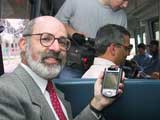 The broadband-wireless bus ferries students between the main UCSD campus in La Jolla, CA, and the Sorrento Valley train station. The trip typically takes 15-20 minutes, enough time for commuters to check email or surf the Web. Passengers can also watch streaming video or listen to high-fidelity music, because they are connected to the Internet in a dedicated 1.25 MHz channel at speeds up to 2.4 Megabits per second--many times faster than conventional "wired" access using 56K modems.
The broadband-wireless bus ferries students between the main UCSD campus in La Jolla, CA, and the Sorrento Valley train station. The trip typically takes 15-20 minutes, enough time for commuters to check email or surf the Web. Passengers can also watch streaming video or listen to high-fidelity music, because they are connected to the Internet in a dedicated 1.25 MHz channel at speeds up to 2.4 Megabits per second--many times faster than conventional "wired" access using 56K modems.
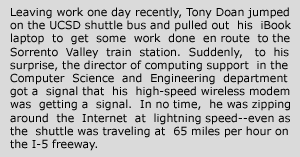
1xEV is formally known as 'CDMA2000, High Rate Packet Data Air Interface Specification' and is QUALCOMM's first 3G offering. The company's facilities are equipped with 1xEV antennas, providing coverage up to a 10-mile radius. In 2001, the company installed similar equipment on top of the nearby Jacobs School for use in engineering, wireless, and related research projects. A team led by ACT's Lou Forbis and Don McLaughlin configured and deployed the broadband system for the bus, linking an off-the-shelf 802.11 access point with a 1xEV modem, both running on electric power from the bus's battery.
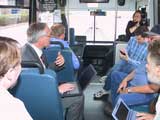 Now that the mobile broadband system is up and running on the bus, researchers are looking for other ways to experiment with the technology. "We are getting ready to test a backpack version," said Hidley. "It's an access point-in-a-box that would allow you to take it anywhere on campus and create a zone within a radius of 300 feet where users could get onto the Internet using 802.11b and CDMA2000 1xEV technology."
Now that the mobile broadband system is up and running on the bus, researchers are looking for other ways to experiment with the technology. "We are getting ready to test a backpack version," said Hidley. "It's an access point-in-a-box that would allow you to take it anywhere on campus and create a zone within a radius of 300 feet where users could get onto the Internet using 802.11b and CDMA2000 1xEV technology."
Related Links
